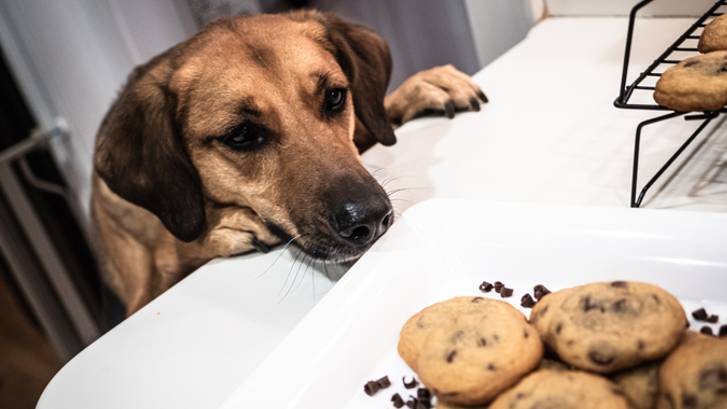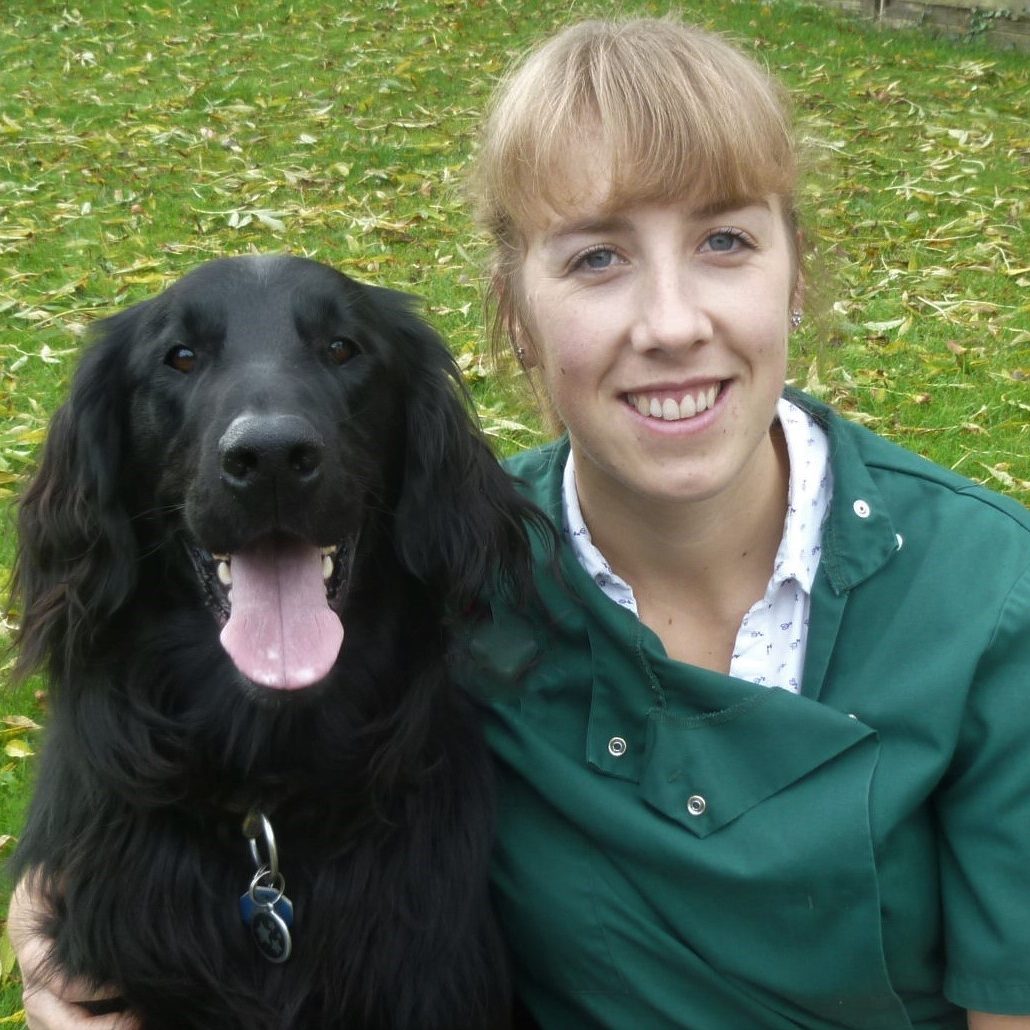Vet reveals everything you need to know about chocolate poisoning in dogs (plus what to do if your pup eats some)
Worried about chocolate poisoning in dogs? Here's the symptoms to be on the lookout for and how to treat it.

Chocolate poisoning in dogs is one of those situations that almost every pet parent dreads finding themselves in. But while you likely already know that this sweet treat is toxic for dogs, you may be wondering how much chocolate your pup would need to consume for it to be dangerous and what symptoms to be on the lookout for.
We were curious about this ourselves, which is why we’ve consulted expert vets Dr. Catherine Barnette and Dr. Rebecca MacMillan to get answers to all our burning questions. They let us know that the reason chocolate needs to stay out of reach of dogs is because it contains caffeine and theobromine, two substances that can have harmful effects on a dog’s nervous system, cardiovascular system, kidneys and gastrointestinal tract.
If consumed in quantities deemed large in relation to your dog’s size, chocolate can be fatal. That’s why it’s so important that you stick to rewarding your canine companion with the best long lasting dog chews and treats and keep any chocolate out of reach of your pup’s paws.
Understandably, you likely have lots more you want to know about this issue. Thankfully, Dr. Barnette and Dr. MacMillan were only too happy to share their knowledge in this area, so below you’ll find a wealth of information relating to chocolate poisoning in dogs, including signs your dog may have consumed chocolate and what to do if they have.
Can dogs eat chocolate?
No matter how adorably they beg, it’s important to resist the temptation to give your dog chocolate. Depending on your dog’s size and the type of chocolate that you give (some are more toxic than others), even a very small amount of chocolate can be fatal.
Instead of giving your dog chocolate, which can be toxic, stick to feeding them the best dog treats. These snacks are specifically developed to be both safe and tasty for dogs.
If you want to give your dog small amounts of human food, avoid chocolate and stick to human foods that are safe for dogs. Using appropriate treats can help you bond with your dog in a way that is safe for them. Check out our guide to what human food can dogs eat for a list of suitable options.
Get the best advice, tips and top tech for your beloved Pets
Why can't dogs eat chocolate?

Chocolate is toxic to dogs because they cannot readily process the caffeine and theobromine that it contains. Humans can metabolize and excrete these compounds much more easily than dogs can, which is why chocolate is safe for us to consume.
In dogs, the build-up of these substances in their body can cause toxic side effects including vomiting, diarrhea, hyperexcitement, tremors, seizures, and even death.
The amount of caffeine and theobromine varies between different chocolate products. As a general rule, the darker the chocolate the more dangerous it is, with cooking chocolate, cocoa powder, and dark chocolates often causing serious problems.
Chocolate toxicity is dose-dependent, meaning that the more chocolate that is consumed the more risk there is to your pet. Equally, bodyweight plays a part, with small dogs much more susceptible to chocolate poisoning than larger dogs that consume the same amount.
Toxic effects may not be seen for two to 24 hours post ingestion, so even if your dog seems fine after eating chocolate you must get them to a vet as soon as possible so that treatment is started early.
How much chocolate can a dog have before it's fatal?
The toxic dose of chocolate varies, depending on the dog’s size and the methylxanthine content of the chocolate. Unsweetened baker’s chocolate and semisweet chocolate, for example, contain far more caffeine and theobromine than milk chocolate.
For a five pound dog, just half an ounce of unsweetened baker’s chocolate could be fatal. An eighty pound Labrador Retriever, however, could likely survive the ingestion of twenty ounces of milk chocolate.
The risk of death associated with chocolate ingestion varies, depending on the dog’s weight, the quantity of chocolate ingested, and the type of chocolate ingested.
It’s important to remember that death isn’t the only risk associated with chocolate toxicity. Even if your dog has not consumed a fatal dose, they may still require medical treatment. The doses of chocolate that cause seizures are typically considered to be a fatal dose, for example, but seizures can be fatal without treatment.
Symptoms of chocolate poisoning in dogs

Because chocolate affects the nervous system, stomach, heart, kidneys, and muscles, the symptoms of chocolate toxicity reflect the effects of chocolate on these organs and systems.
In the early stages of toxicity, you may notice vomiting in dogs, restlessness, increased thirst, and a bloated appearance to the belly. These signs are often followed by increased excitability, increased urination, and muscle tremors. In severe cases, your dog may develop seizures, generalized muscle rigidity, excessive panting, and even a loss of consciousness.
On a veterinary exam, your veterinarian may also notice a heart arrhythmia (irregular heart rhythm), increased blood pressure, and an elevated body temperature.
What to do if your dog eats chocolate
If you are concerned that your dog has ingested chocolate, contact your veterinarian, emergency veterinarian, the Pet Poison Helpline, or Animal Poison Control immediately.
A veterinarian or veterinary technician can assess whether your dog’s chocolate ingestion is likely to have toxic effects, and determine whether your dog needs emergency treatment.
Treating chocolate poisoning in dogs
If your dog’s chocolate ingestion was very recent, your veterinarian will attempt to clear the chocolate from the gastrointestinal tract before it is absorbed.
This may involve inducing vomiting, or giving your dog activated charcoal that will bind to chocolate and prevent its absorption. Your veterinarian may also perform gastric lavage, or “pump the stomach,” to further reduce chocolate absorption.
Treatment of chocolate toxicity is supportive in nature. There is no antidote for chocolate toxicity. Instead, your veterinarian will give your dog intravenous fluids to flush caffeine and theobromine out of your dog’s circulation.
Medications will be given as needed, to control high blood pressure, seizures, muscle tremors, heart arrhythmias, vomiting, and hyperactivity.
How long does it take for chocolate to get out of a dog's system?

Signs of chocolate toxicity typically develop approximately four to six hours after ingestion, and the duration of your dog’s signs will largely depend on how much chocolate your dog ingested.
Caffeine is cleared from the system quickly, but theobromine is cleared from the circulation relatively slowly. Signs of chocolate toxicity will resolve once your dog’s blood levels of theobromine fall to normal levels. In dogs, blood theobromine levels fall by approximately 50% every 18 hours.
After 36 hours, your dog’s theobromine levels will be about a quarter of what they were at their peak. After three days (72 hours), your dog’s theobromine levels will be down to 6% of what they were at their peak.
Depending on your dog’s blood theobromine levels at their peak, the effects of chocolate toxicity resolve within one to four days.
Can a dog recover from chocolate poisoning?
Your dog’s prognosis will depend on the quantity and type of chocolate ingested, your dog’s size, and how promptly you seek veterinary care. With this information, your veterinarian should be able to provide you with a reasonably accurate idea of what to expect in your dog’s situation.
Dogs ingesting a very small amount of milk chocolate may experience only a brief period of vomiting and diarrhea. With appropriate supportive care (medications and fluid support) these dogs should not experience any significant or permanent effects.
However, dogs that ingest large amounts of methylxanthines or experience a significant treatment delay may not survive, even with aggressive treatment.
Is there a chocolate that's safe for dogs?
Dogs should not eat any type of chocolate at all. Even white chocolate, which contains no cocoa powder and is therefore not toxic, is still high in fat and sugar. This could lead to weight gain or trigger an episode of painful pancreatitis in susceptible dogs. You should always stick to your dog’s normal pet food where possible but if you want to give them a human snack then small pieces of cooked chicken, cooked turkey, or vegetables like carrots or cucumber are best.
However, if you'd like to give your pup the occasional sweet treat, the ASPCA state that carob (which comes from the pods of an evergreen tree in the Mediterranean) is safe for dogs to consume. Naturally sweet, it contains no dairy and is caffeine and theobromine-free. Non-toxic, it has low amounts of sugar and fat and comes packed with fiber and antioxidants.
Bocce's Bakery Mud Pie Oh My Training Treats for Dogs
With a short ingredient list containing only real ingredients, these delicious and nutritious training treats are sure to be a huge hit with your pup.
In order to avoid chocolate poisoning in dogs, it’s important to not let dogs eat chocolate. While the highest toxicity risks are associated with baker’s chocolate, semisweet chocolate, and other concentrated forms of chocolate, even milk chocolate can prove fatal, depending on the amount ingested.
If you suspect that your dog may have ingested chocolate, contact your veterinarian or an animal poison hotline immediately to determine what care your dog needs.
Read next: can dogs have fish skins?

Dr. Barnette is a graduate of the University of Florida, where she received both her B.S. in Zoology and her Doctor of Veterinary Medicine (DVM). She has 15 years of clinical experience as a small animal veterinarian, treating dogs, cats, and occasional exotic patients. She now works as a freelance veterinary writer, creating educational content for veterinarians, veterinary team members, and dedicated pet owners.

Rebecca is a vet surgeon who graduated from the Royal Veterinary College in 2009. She has a wealth of experience in first opinion small animal practice, having done a mixture of day-to-day routine work, on-call emergency duties and managerial roles over the years. She enjoys medicine in particular and she is proud to have recently achieved a BSAVA postgraduate certificate in small animal medicine (with commendation). She writes on various feline and canine topics, including behavior, nutrition, and health. Outside of work and writing she enjoys walking her own dog, spending time with her young family and baking!
Dr. Barnette is a graduate of the University of Florida, where she received both her B.S. in Zoology and her Doctor of Veterinary Medicine (DVM). She has 15 years of clinical experience as a small animal veterinarian, treating dogs, cats, and occasional exotic patients. She now works as a freelance veterinary writer, creating educational content for veterinarians, veterinary team members, and dedicated pet owners. Dr. Barnette lives in southwest Florida with her husband and daughter (plus two cats, a dog, and a rescued dove!) and enjoys kayaking, biking, and hiking. Learn more about Dr. Barnette at www.linkedin.com/in/catherinebarnette.


